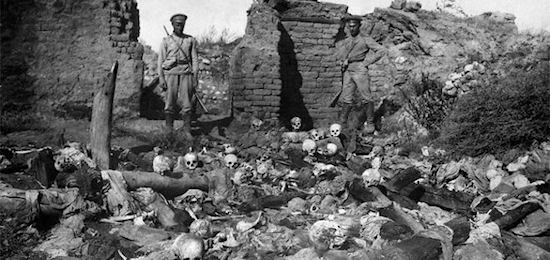The Armenian massacres in Turkey started in the 19th century and continued well after the Armenian genocide of 1915 in which some 600,000 Armenians perished. The Armenians were also raided by Kurdish tribesmen on a regular basis.
An Ottoman military tribunal, convened between 1919-21, even convicted for the crimes members of the administration of the Young Turks, including cabinet ministers.
Many of the perpetrators fled the country only to return, triumphant, after the establishment of modern Turkey in 1923. The Turkish government today denies that an organized, premeditated genocide ever took place and pegs the number of Armenian fatalities at 200-300,000 at the most.
Towards the end of the 19th century, the Armenians formed guerrilla movements in eastern Van (the Armenakans, in 1885) and in Russia. Radical nationalist parties were established by Russian-Armenian emigrants in 1887 (Hunchak or Henchak, "The Bell") and in 1890 in Georgia (Dashnak or Dashnaktsutyun, "Union"). Mass demonstrations in the Turkish capital (in 1890 and 1895) and armed uprisings followed (in 1894-5). The Dashnaks even invaded Turkey from Russia in 1896 - a demonstrative act which resulted in the slaughter of 50,000 Armenians.
The suppression of these revolts claimed 200,000 Armenian lives. In 1909, in Adana, more than 23,000 Armenians were massacred as the warships of the Great Powers stood idly by. In 1912-3 the Great Powers, led by Russia, pressured Turkey to cease its mistreatment of the Armenians. This intervention was resented by the Ottoman authorities. By 1915, Armenian calls for autonomy were deemed a danger to the disintegrating realm, now at war with Russia.
When the first world war broke, Turkey allied itself with the Germans. All Armenian men aged 20-45 were conscripted to the army as soldiers, soon to be disarmed and serve as pack animals or in menial jobs. When Russian Armenians recruited Turkish Armenians for the anti-Turkish Russian Army of the Caucasus, in April 1915, the elite of the Armenian community was arrested and executed. Between May and June 1915 the Armenian population was deported to Mesopotamia. The deportation followed mass executions.
Many more died from starvation, exposure, dehydration, abuse and outright torture. The survivors - less than 300,000 - were subjected to additional slaughter in Syria. People were beaten with blunt instruments, burnt alive or drowned forcibly. The massacres were carried out by military officers with dictatorial powers, aided by criminals especially released from jails and assigned to their gruesome duties.
Armed resistance in Van province, Mussa Dagh, Shabin Karahisar and Urfa - as well as setbacks in the war - prevented the Turks for deporting the urban Armenian population in the Ottoman Empire's major cities. Today there are less than 60,000 Armenians in Turkey compared to at least 1.8 million in 1910.




